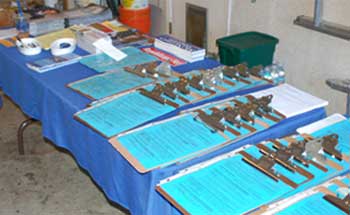 |
 |
Entering information into the database after a walk mobilization consumes enough of your staff’s time and patience as it is – but when canvassers fill out their walk-sheets incorrectly, the process can become a real headache. The best prevention is good training.
 Decoding the walk list
Decoding the walk list Walk lists are seldom straightforward. These closely-printed lists contain a great deal of highly condensed information including voters’ names, addresses, ID numbers or barcodes. They may also indicate voting frequency and sometimes organizers choose to print walk lists that indicate voters’ previous interactions with the organization or project – for instance, issues they ID’d in conversation with another canvasser. If canvassers are doing a survey, the walk lists needs a place where they can circle voters' responses. (For more on walk-sheets, see List Production and Data Entry).
A typical walk list has multiple fields, abbreviations and codes; a canvasser has to understand what all the pieces mean in order to fill out the sheet properly. Furthermore, they’ve got to know how to get the right information out of voters and accurately record their responses. ALLERT organizers, Anthony Thigpenn explains, teach canvassers (or “precinct leaders”) about the walk list itself – the “universe” of voters they’ll be contacting – as well as how to record ambivalent or unclear responses. During field training, they also go over the script with canvassers and set up short role play activities to get them comfortable with the key points of the questions. Have canvassers practice asking the questions that they’ll ask voters and discuss how they’d mark different answers.
If all goes well, canvassers will return from door-knocking with information about the voters they contacted marked on their walk lists that staff members (or other volunteers) can easily input into the database. In the second video, Risa Brown, SCOPE’s Information Technology Associate, goes through the folder that ALLERT sends out with each team of door-knockers and briefly explains how they “wand” in the data after the canvass (that is, use a barcode reader to quickly enter voters’ responses into the database.) We’ll hear more from Risa about this incredibly efficient method of data-entry in the Barcode Scanner section.
In the third video, you can watch an excerpt of a field materials training session with a group of canvassers in Los Angeles. Volunteers gathered in the morning morning, signed in, had coffee and listened to Anthony Thigpenn and other organizers do a pep talk and issue education about the two initiatives they’re campaigning to defeat, Propositions 66 and 72 . They then split up into smaller groups for field materials training. Gloria Walton spends the bulk of this time explaining the walk list, line by line, decoding every abbreviation and pertinent field, and rehearsing the key points about the two ballot initiatives that are central to the campaign’s message. (At one point a volunteer asks, “How many billions was it that this initiative’s going to cost? Ten-point-two or ten-point-three?” Gloria answers that the volunteer needn’t get too caught up with the exact number – the point was it was a lot, and large corporations would see most of the benefit. This is a great lesson in encouraging canvassers to keep their pitch simple; as Anthony Thigpenn has said, it’s SCOPE’s goal for volunteers to be great canvassers without needing to be experts.)
The canvassers will be carrying a flyer about the campaign which Gloria tells them they can offer to everyone on their list and leave for people who aren’t home. The flyer has a tear-off portion where voters can mark if they’re interested in volunteering; “it’s always important to recruit,” Gloria says. They’re also walking with a nonpartisan voter guide that provides information on other ballot initiatives which they should distribute only if requested; __ reminds canvassers that their priorities are Props. 66 and 72 and they won’t have time to engage in conversation on other issues.
Click to hear from an organizer
Anthony Thigpenn: training volunteers to correctly record responses
Risa Brown, ALLERT's IT specialist, explains what's in the precinct leaders' folder
Gloria Walton, an ALLERT organizer, trains volunteers on their fieldwork materials
Check out more Field Organizing Training Materials in the Resources Section